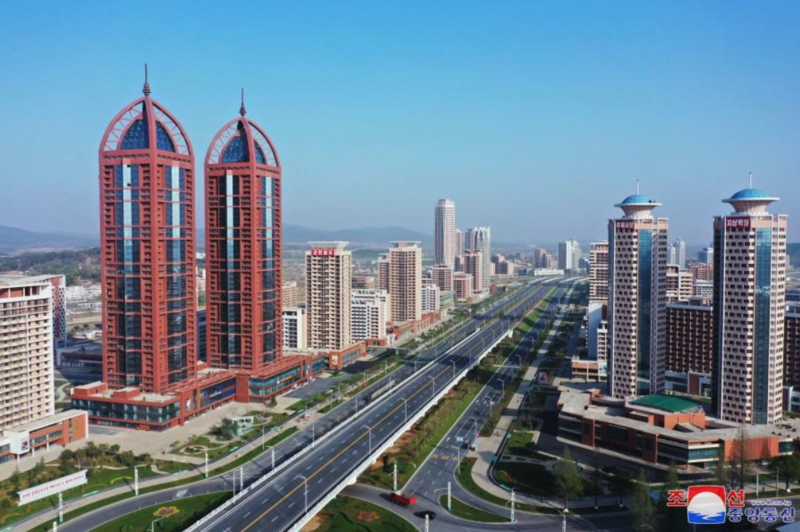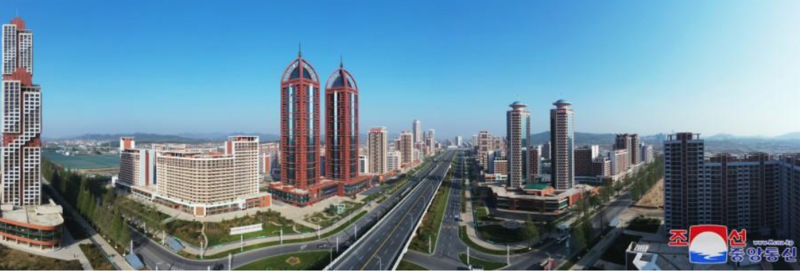Part 3: Buildings on Hwasong Street, the 1st stage of the Hwasong District
In the first blog of this series, we introduced the 10,000 new flats in Rimhung Street, the second stage of the Hwasong District. In part 2, we explained the meaning of the word “Phase” in the North Korean context and introduced the first phase of the 50,000 New Flats Project in Pyongyang.
In this blog, we will introduce the second Phase of the Pyongyang Flats Project – the first stage of Hwasong District, the 10,000 new flats of the year 2022 in the Hwasong Area.
This is also known as Hwasong Street.

“Stage” in North Korea, What Does it Mean?
We introduced the term "Phase" in the previous blog.
But here comes a new comparable word, “Stage”.
In the North Korean context, "Stage" and "Phase" have similar meanings. They both refer to the step-by-step completion of a plan. However, a Stage is a more detailed subdivision within a Phase.
In the 50,000 New Flats Project in Pyongyang, Hwasong District encompasses the second to fourth Phases. Within Hwasong District, Hwasong Street is the first Stage, and Rimhung Street is the second Stage.
Basic Information of Hwasong Street
On February 12, 2022, North Korea held a ceremony for the 10,000 new flat construction project of the year 2022 in Pyongyang.
Hwasong District is located in North Pyongyang, it was once a part of Ryongsong District. Two months after its construction, the Hwasong Area was separated from Ryongsong District to establish the new Hwasong District.
Hwasong Street is located on the road from Pyongyang Sunan International Airport to Pyongyang's city center.
Hence, Hwasong Street may become one of the first visually striking and distinctive new building complexes in Pyongyang that travellers can see after arriving in North Korea by plane.
Additionally, the Kumsusan Palace of the Sun is situated to the southeast of this area, not far away.
This was one of the reasons why this area had not previously undergone large-scale urban development.
Construction of New Buildings in Pyongyang During the Peak of the Pandemic
Actually, Hwasong Street has a quite difficult and arduous history.
In May 2022, North Korean state media acknowledged the widespread transmission of COVID-19 within the country, removing North Korea from the list of nations officially declared as clear of COVID-19.
In response to the outbreak, Kim Jong Un declared a "severe national emergency" and imposed a country-wide lockdown.
On May 12, 2022, the Workers' Party of Korea held an emergency meeting about the current situation.
According to the meeting, the construction of the Hwasong area was one of North Korea's top priorities for 2022. So, the lockdown should not affect its construction, which means workers had to continue to work during the pandemic.
On April 16, 2023, the day after the Day of the Sun (which no longer exists), after 14 months of construction, North Korea held the completion ceremony of the Hwasong District. These new buildings in Pyongyang finally became a new landmark of the city.
Origin of the Name Hwasong
So, what does the name Hwasong (화성) really mean?
The first time you come across the name "Hwasong Street," it might sound very familiar if you have some knowledge of North Korea's military.
"Hwasong" is the name of the North Korean ballistic missile "HwasongPo", meaning "Missile of Mars."
However, in the context of Hwasong Street, "Hwa" and "Song" means "harmony and prosperity."
The name originates from a historical site in the area called Hwasong Jae. It was intended to inspire people to study diligently to foster harmony and prosperity in the village. A "Jae" is a traditional East Asian building used for storing books, writing, and painting.
The Hwasong missile embodies a certain sense of national pride and is kind of a national symbol of North Korea.
Given that Hwasong Street shares the same name with the missile, North Korea would not miss the opportunity to show off its craftsmanship and unique Juche-style architectural aesthetics.
Hwasong Street
It is time to see the new buildings on Hwasong Street.
The overall colour tone of Hwasong Street is light red, reddish brown, and white, and the overall architectural style is somewhat similar to Future Scientists Street.
The new buildings here are classic futurist Juche-style buildings, with elements of missiles and even UFOs. Among all the new buildings in Pyongyang, it's a street that you can easily recognize.
It's worth mentioning that there's a Matusan Electric Vehicle Exhibition Hall on Hwasong Street.
When images of the Matusan electric vehicles were first released, some speculated that they were simply rebadged BYD cars.
So, when taking a tour with Koryo Tour, you can ask your local Korean guides about the development of electric vehicles in North Korea.
If you want to see detailed footage of the Matusan electric vehicles, this video from the Matusan Economic Federation includes an introduction to its electric cars.
Landmarks of New Buildings on Hwasong Street
Let’s take a closer look at Hwasong Street’s landmarks.
The most unique landmark of Hwasong Street is a pair of 40-storey missile-shaped twin towers.
In the initial design, there was only one white missile-shaped building, but the number and color were changed in the construction. These buildings prominently incorporate military and technological elements due to the shared name with the Hwasong missile.

The initial design of Hwasong Street.
Opposite the missile-shaped twin towers, there's a pair of 30-storey twin towers with UFO-shaped rooftops, making them just as unique in design.
Another landmark on Hwasong Street is a pair of twin towers that are identical in design but differ in the number of floors.
These two new buildings were added in September 2022 when Kim Jong Un inspected the construction site. He believed that the original plan left too much open space, making the street appear unbalanced. To fix this problem, more than 2,000 new flats were added to the vacant land.
One of these towers is 60 storeys tall, while the other is 30 storeys. The main bodies of the twin towers are light red, and the exterior features a spiral-wrapped white pattern design, making them stand out at night with their unique lighting design.

You can see these three sets of twin towers from left to right.
Future of New Buildings in Pyongyang
The construction of Hwasong District has already been completed Stage 1 and Stage 2 in 2022 and 2023 respectively.
The construction of Stage 3 has already begun in 2024, with Stage 4 planned for future development.
When all four stages are completed, it will form a unique landscape mixing different forms of Juche-style buildings.
Hopefully, in tours in 2026, we will be able to see the Hwasong District New Urban of Pyongyang with our own eyes.
Since North Korea has announced that international tourism within the Samjiyon area will resume soon later this year, please continue to follow our website and social media to receive the latest information about North Korean tourism.
